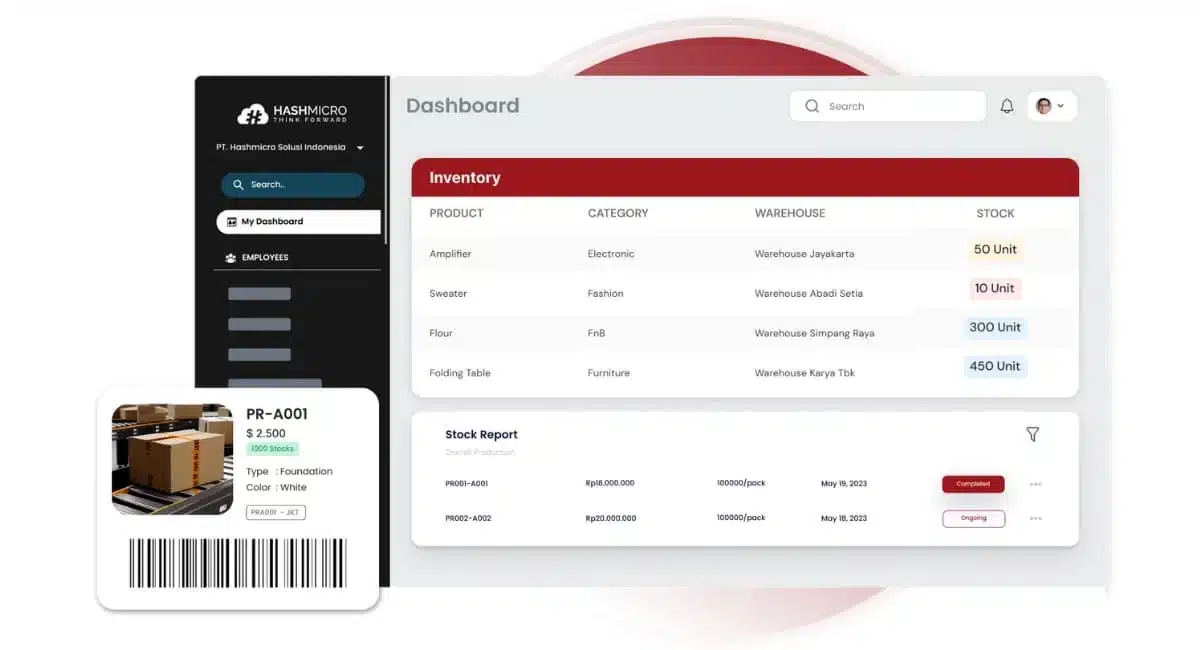Are inventory problems like overstocking or stock shortages holding your business back? Efficient stock management is essential for growth, but without the right system, it can be a challenge.
A study on Right Goods Philippines Incorporated showed that implementing an inventory control system led to a 27.4% increase in sales through improved stock management and promotions.
If you want to maximize profits and streamline operations, HashMicro’s Inventory Control System is the solution! With real-time tracking, automation, and seamless stock monitoring. It helps businesses eliminate inefficiencies and reduce errors.
One of its standout features RFID warehouse rack automation, ensures smooth inventory tracking. Alamin pa ang inventory control system na ito at ang advanced na tampok ng HashMicro!
Key Takeaways
|
Table of Contents

What is Inventory Control?
Inventory control is the process of managing stock levels to ensure businesses have the right amount of products at the right time. It helps prevent overstocking, which ties up capital, and stockouts, which lead to lost sales.
A well-implemented inventory control system improves efficiency and reduces waste. This system extends beyond merely counting products; it is crucial for efficient business operations. Additionally, by systematically tracking inventory levels, businesses avoid overstocking or understocking, preventing lost sales and increased costs.
To support this, many software providers offer inventory control systems that automate and streamline the process. This also makes inventory management more accurate and less labor-intensive.
Why Is Inventory Control Important?
Inventory control plays a vital role in ensuring a product-based business operates efficiently and profitably. Below are key reasons why implementing an effective inventory control system is essential:
1. Optimize working capital
Inventory is a significant portion of current assets for many businesses. By managing stock levels efficiently, companies can free up funds tied to excess inventory, enabling investment in expansion, innovation, or profit maximization.
2. Avoid overstock and shortages
An inventory control system helps businesses strike the perfect balance between having too much stock and running out. Overstock leads to issues like spoilage, excess storage costs, or dead stock, while shortages result in lost sales and dissatisfied customers.
3. Improve customer satisfaction
Effective inventory control ensures products are always available to meet customer demand. With 62% of customers abandoning brands due to poor service, avoiding out-of-stock is crucial to retaining loyalty and maintaining sales.
4. Reduce operational costs
By optimizing inventory processes, businesses can cut costs associated with storage, spoilage, and excess stock handling. This creates a leaner operation that allocates resources more effectively.
5. Enhance supply chain efficiency
Inventory control improves visibility across the supply chain, reducing the risk of misplaced or lost goods in the warehouse. This streamlining allows businesses to respond more quickly to market demands and customer expectations.
6. Boost profitability
Proper inventory management directly contributes to increased profitability. Lowering inventory costs frees up cash flow while avoiding lost sales due to shortages and ensures a steady revenue stream.
7. Prevent loss of loyal customers
Out-of-stock scenarios can lead to lost customers, with research showing 55% of shoppers refuse to buy alternatives if their preferred product isn’t available. Inventory control mitigates these risks and builds stronger customer relationships.
8. Minimize spoilage and dead stock
Inventory control systems help track product lifecycles and avoid excess stock that may become unsellable. This prevents losses caused by spoilage or outdated goods, ensuring better cost-efficiency.
Implementing an inventory control system isn’t just about keeping track of stock, it’s a strategic move that drives business success. From optimizing working capital to enhancing customer satisfaction, effective inventory control ensures a company stays competitive, efficient, and profitable.
What are Common Inventory Control Problems and Challenges?
Inventory control problems and challenges can disrupt business operations and affect profitability. Some common issues include:
-
Overstocking & Stockouts: Holding too much inventory ties up capital and storage space, while running out of stock leads to lost sales and unhappy customers.
-
Inaccurate Inventory Data: Errors in stock records due to manual tracking or system failures can result in discrepancies, leading to poor decision-making.
-
Poor Demand Forecasting: Without accurate demand predictions, businesses may overestimate or underestimate stock needs, causing inefficiencies.
-
Supplier Issues: Delays, inconsistent quality, or unreliable suppliers can disrupt inventory flow and affect customer satisfaction.
-
Theft & Shrinkage: Loss of inventory due to theft, misplacement, or damage reduces profitability and may go unnoticed without proper tracking.
-
Inefficient Storage & Organization: Poor warehouse management can lead to misplaced stock, slower order fulfillment, and increased operational costs.
-
Technology Integration Issues: Many businesses struggle to implement or integrate inventory control software with other systems, leading to inefficiencies.
-
Regulatory Compliance: Some industries require strict inventory tracking for compliance with safety or legal regulations, which can be challenging without proper systems.
Addressing these challenges requires efficient inventory control strategies, such as automated tracking, regular audits, and better supplier management.
Benefits of Inventory Control Systems
These systems streamline operations and reduce costs by enabling real-time stock tracking. This capability allows businesses to respond swiftly to market demands and adjust inventory levels accordingly, maintaining operational efficiency.
Key benefits of an inventory management system include:
- Optimized Logistics: By ensuring that the right products are at the right place at the right time, this system reduces transportation costs and improves delivery times, enhancing the overall logistics process.
- Significant Cost Savings: Effective inventory management minimizes unnecessary stock holding and reduces the costs associated with excess inventory, such as storage fees and spoilage.
- Enhanced Customer Satisfaction: With better stock management, businesses can prevent stockouts and backorders, ensuring that customer orders are fulfilled promptly and accurately, which leads to higher customer satisfaction and loyalty.
Adopting a robust system is essential for keeping your business competitive and profitable in a fast-paced market. By ensuring efficient inventory management, you can meet customer demands effectively while maintaining a streamlined supply chain, positioning your business for long-term success.
Inventory Control vs. Inventory Management
Inventory control focuses on maintaining optimal stock levels to avoid overstocking or running out of items and ensure product availability, including managing seasonal inventory fluctuations driven by demand cycles. It involves real-time tracking and regulating inventory flow, which is crucial for maintaining smooth operations, minimizing carrying costs, and meeting customer demands throughout peak and off-peak periods.
On the other hand, inventory management encompasses a broader scope, including the entire inventory lifecycle, from procurement to sale. It involves controlling stock levels, managing supplier relationships, forecasting demand, and ensuring efficient order fulfillment.
| Aspect | Inventory Control | Inventory Management |
|---|---|---|
| Scope | Focuses on existing inventory in the warehouse | Deals with raw materials and finished goods throughout the entire production lifecycle |
| Goal | Ensuring stocks in the warehouse are enough and in good condition | Aiming to have the right inventory in the right place, at the right time, and in a sufficient quantity |
| Areas of Concern | – What items are in the inventory? – Where are these items located in the warehouse? – What is the condition and status of these items? |
– Which items should you order? – How many items do you need to order? – When should you order these items? |
| Actions | – Receiving, storing, and transporting inventory – Checking stock items for expiry dates, spoilage, quality issues, etc. |
– Predicting customer demands based on previous data – Reordering and managing inventory items in the supply chain |
Types of Inventory Control Systems
Inventory control systems help businesses manage stock efficiently, ensuring accurate tracking and optimal inventory levels. These systems come in different types, each offering unique methods to monitor, organize, and control inventory based on business needs. They are typically divided into two types:
1. Periodic inventory system
A periodic inventory system is a method where inventory counts are conducted at regular intervals, such as weekly or monthly. This approach allows businesses to assess their stock levels periodically, which can help in budgeting and planning for future inventory needs.
However, this system can lead to inaccuracies between counts, as it doesn’t track inventory changes in real-time. For businesses integrating storage and inventory control in their business plan, relying solely on periodic counts might result in discrepancies.
2. Perpetual inventory system
A perpetual inventory system offers continuous, real-time tracking of stock levels, leveraging technology like barcode scanners or RFID. This system ensures that every stock movement is recorded instantly, providing accurate data for decision-making.
For businesses, especially those focused on storage and inventory control in their business plan, perpetual systems enhance inventory management by reducing errors and improving stock accuracy.
Periodic and Perpetual inventory system is tailored to specific business needs, optimizing stock levels and improving operational efficiency across different environments. Furthermore, this customization ensures that the system adapts seamlessly to varying operational demands, enhancing overall effectiveness.
Inventory Control Techniques and Methods
Effective inventory control relies on various techniques to maintain the right stock levels, minimize costs, and meet customer demands. Here are 10 techniques you could implement in your business:
1. ABC inventory
ABC inventory is a technique for separating items into three classes based on their importance and value to help prioritize resources. Class A items are the most valuable and require the most attention, while classes B and C represent less critical items.
Businesses can optimize inventory monitoring and allocate resources efficiently by focusing on high-value items. Prioritizing class A items in storage and inventory control systems ensures that crucial stock is always available.
2. FIFO and LIFO
FIFO (First-In, First-Out) and LIFO (Last-In, First-Out) are techniques for managing stock rotation. The FIFO ensures that the oldest inventory is sold first, reducing the risk of obsolescence, while LIFO prioritizes selling the most recently acquired items.
Businesses can use these methods to align their storage and inventory control in their business plan with market demand. For example, FIFO is commonly used in industries where products have expiration dates, ensuring that inventory monitoring is effective and reduces waste.
3. JIT inventory
Just-In-Time (JIT) inventory is a technique where inventory is received only when needed for production or sales, minimizing storage costs and reducing waste. This method requires precise inventory control and reliable suppliers to ensure stock arrives quickly.
JIT inventory helps businesses optimize storage and inventory management by minimizing excess inventory. Moreover, this method can significantly reduce holding costs and improve cash flow in a well-executed storage.
4. Batch tracking
Batch tracking involves monitoring inventory by grouping products based on production batches. This technique is crucial for industries where traceability is essential, such as food and pharmaceuticals, ensuring that inventory control meets regulatory standards.
Batch tracking enables businesses to enhance inventory monitoring by tracking specific batches, thus improving their storage and inventory control system. For instance, companies can use batch tracking to manage the shelf life of perishable goods more effectively.
5. Cross-docking
Cross-docking is a logistics technique where products are directly transferred from inbound to outbound transportation without long-term storage. This method reduces the need for extensive warehouse space, optimizing the storage and inventory control system.
Cross docking as part of inventory control management can streamline operations, reduce storage costs, and improve inventory monitoring. It’s useful for businesses aiming to enhance storage and inventory management in business plan by reducing lead times.
6. Consignment
In consignment inventory, a supplier places goods at a retailer’s location, but the retailer only pays for the items once they are sold. This technique allows for flexible inventory control, reducing the retailer’s risk and ensuring a steady supply of products.
Consignment offers benefits in storage and inventory control management by reducing upfront costs. For businesses integrating this technique into their storage and inventory control system, consignment provides an efficient way to manage stock levels without tying up capital.
7. Materials Requirement Planning (MRP)
Materials Requirement Planning (MRP) relies on accurate sales forecasts to determine inventory needs. By analyzing past sales data, manufacturers can predict future demand and communicate their needs to suppliers on time.
For instance, a ski manufacturer using MRP would ensure that materials such as plastic, fiberglass, and aluminum are in stock based on forecasted sales. The challenge with MRP is that inaccurate sales forecasting can lead to stock shortages or overstocking, both of which can disrupt production and result in unfulfilled orders.
8. Economic Order Quantity (EOQ)
EOQ is an inventory management model that calculates the optimal number of units a company should order in each batch to minimize inventory costs. These costs include both holding costs (costs of storing inventory) and setup costs (costs related to ordering and receiving new stock).
By finding a balance between these two types of costs, EOQ helps companies avoid excessive inventory while still meeting customer demand. The goal is to order inventory in such a way that neither stockouts nor overstocking occurs, which ultimately reduces total inventory costs.
9. Days Sales of Inventory (DSI)
DSI is a financial metric that calculates the average number of days a company takes to sell its inventory, including both finished goods and work-in-progress. Also known as the average age of inventory, DSI measures how quickly inventory is turned over.
A low DSI indicates that inventory is moving quickly, while a high DSI might suggest slow sales or overstocking. Businesses often use this ratio to assess their operational efficiency and determine how well they manage their stock.
10. Days of Inventory Outstanding
One key metric used in inventory control is Days of Inventory Outstanding (DIO), which measures how long a company holds stock before selling it. A lower DIO indicates better efficiency, as excessive stock ties up capital and increases storage costs, a challenge especially for small businesses.
Recent trends show an 8.3% increase in DIO scores over the past five years, highlighting the need for better inventory control practices. Optimizing inventory control systems reduces storage costs and ensures businesses free up working capital, allowing for improved financial stability and growth.
Best Practices for Effective Inventory Control
Implementing this system requires careful planning and execution to maximize efficiency and accuracy. Here are some tips to ensure effectiveness when leveraging AI for inventory management, helping businesses automate stock control, optimize forecasting, and enhance operational workflows.
- Regular stock audits: Conduct frequent stock audits, like cycle counting, to ensure accurate records and early detection of issues such as theft or damage. This practice strengthens inventory control management and prevents costly discrepancies.
- Prioritize inventory management: Focus on managing inventory based on demand, turnover rates, and value. Prioritizing essential items in your storage and inventory control system ensures critical stock is always available when needed.
- Use automated systems: Implement automated inventory control systems for real-time tracking and automated reordering. These systems enhance storage and inventory control, reducing human error and ensuring stock levels meet market demands.
- Optimize warehouse space: Design layouts to maximize efficiency, reduce retrieval times, and prevent overstocking. Effective space utilization in your storage and inventory control system minimizes costs and streamlines operations.
- Forecast demand accurately: Use forecasting tools to anticipate market trends and adjust inventory levels. Accurate forecasting helps maintain optimal stock levels, thus improving overall inventory control management.
- Leverage inventory management system: Automate processes using an inventory management system from HashMicro. This software offers real-time tracking, automated reordering, and analytics, making it easier to maintain inventory control.
Avoiding common pitfalls and implementing other software is also critical for maintaining an accurate inventory. These include failure to update data, ignoring supplier performance, and neglecting customer feedback on product quality.
How Can HashMicro Help Your Inventory Control Process
HashMicro’s Inventory Software is tailored to enhance operational efficiency and streamline stock management processes. Utilizing advanced technology, HashMicro offers a comprehensive solution addressing modern businesses’ core challenges.
Some Features of HashMicro’s Inventory Control System:
- Stock forecasting: Predicts future inventory has never been easier with historical data and trends. This helps businesses manage stock levels effectively, reducing overstocking and stockouts while ensuring that inventory meets demand accurately.
- Fast moving & slow moving stocks analysis: This feature identifies fast and slow-moving items. By analyzing sales velocity, businesses can optimize inventory levels, improve stock turnover, and make informed purchasing decisions to enhance profitability and reduce excess inventory.
- Stock reservations & reporting: It allows businesses to reserve stock for specific orders and generates detailed reports on inventory status. This ensures accurate tracking, efficient order fulfillment, and better inventory control.
- RFID warehouse rack stock in & out automation: HashMicro uses RFID technology to track stock movements in real time. This enhances accuracy and efficiency in managing inventory, reducing manual errors, and streamlining warehouse operations.
- Product expiry management: Tracking product expiry dates and sends reminders. Additionally, it ensures timely use or disposal of perishable items, helping manage inventory effectively and comply with quality standards.
Adopting HashMicro System can transform your inventory management into a dynamic and proactive business component. With its powerful features, it not only ensures operational excellence but also supports sustained business growth by adapting to changing market conditions.
Conclusion
Inventory control is crucial for businesses to manage stock levels efficiently, reduce costs, and avoid operational disruptions. Proper inventory management system helps ensure that products are available when needed, which enhances customer satisfaction and supports profitability.
HashMicro Inventory Management Software offers a robust solution to streamline inventory processes. With real-time tracking and automated updates, the software helps maintain optimal stock levels and improves accuracy, making it a valuable tool for effective inventory management.
To further experience the benefits, schedule a free demo for HashMicro Inventory Management Software today. See how it can transform your inventory management and meet your business needs with a tailored solution.
Frequently Asked Questions
-
What is the importance of an inventory control system?
This system is crucial for maintaining optimal stock levels and avoiding overstocking or stockouts. It enhances operational efficiency and customer satisfaction by ensuring products are available when needed.
-
What is an example of inventory control?
A common example of this is the use of a barcode system to manage stock levels in real-time. This method allows businesses to monitor inventory movements and adjust orders accordingly and accurately.
-
What is the basic purpose of inventory control?
The primary purpose is to manage the supply chain efficiently by maintaining the right balance of stock. It aims to minimize holding costs and maximize the availability of goods to meet customer demands.























